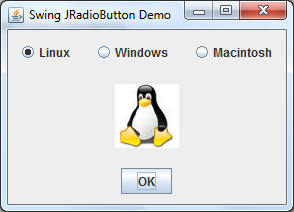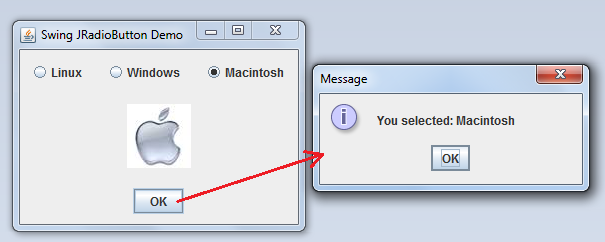JRadioButton basic tutorial and examples
- Details
- Written by Nam Ha Minh
- Last Updated on 06 July 2019 | Print Email
Table of content
JRadioButtonis a Swing component that represents an item with a state selected or unselected. Usually a group of radio buttons is created to provide options to the user, but only one option can be selected at a time. The following screenshot show a group of three radio buttons placed on a JFrame:

Here’s the code to create a simple program above:
import java.awt.FlowLayout;
import javax.swing.ButtonGroup;
import javax.swing.JFrame;
import javax.swing.JRadioButton;
import javax.swing.SwingUtilities;
public class SwingJRadioButtonDemo extends JFrame {
public SwingJRadioButtonDemo() {
super("Swing JRadioButton Demo");
JRadioButton option1 = new JRadioButton("Linux");
JRadioButton option2 = new JRadioButton("Windows");
JRadioButton option3 = new JRadioButton("Macintosh");
ButtonGroup group = new ButtonGroup();
group.add(option1);
group.add(option2);
group.add(option3);
setLayout(new FlowLayout());
add(option1);
add(option2);
add(option3);
pack();
}
public static void main(String[] args) {
SwingUtilities.invokeLater(new Runnable() {
@Override
public void run() {
new SwingJRadioButtonDemo().setVisible(true);
}
});
}
}Let’s look at other common practices when working with the JRadioButton component.
1. Creating new JRadioButtion components
There are several ways to construct a new JRadioButton, but the most common way is to pass some text to its constructor, for example:
JRadioButton optionLinux = new JRadioButton("Linux");In addition to the text that tells what the option is for, it’s possible to specify an icon and selected state in any combination of [text, icon, selected]. Here are some examples:
- Creating a radio button with an icon:
JRadioButton optionLinux = new JRadioButton(ImageIcon("images/linux.png"));However, because the icon replaces the default appearance of the radio button, so it’s not common to specify an icon for a radio button.
- Creating a radio button with text and selected state (true or false):
JRadioButton optionWin = new JRadioButton("Windows", true);Of course we can set the text and selected state for a radio button after it is created, for example:
optionWin.setText("Windows");
optionWin.setSelected(true);We can also pass an instance of a class that implements the javax.swing.Action interface when creating a radio button. Using an Action is useful in case we have multiple components that share same properties and state like a menu item, a check box, a button, etc. Here’s an example that creates a radio button with caption “Macintosh” and selected state:
Action action = new CommonAction("Macintosh", true);
JRadioButton optionMac = new JRadioButton(action);Where the CommonAction class is declared as follows:
class CommonAction extends javax.swing.AbstractAction {
public CommonAction(String text, boolean selected) {
super(text);
super.putValue(SELECTED_KEY, selected);
}
@Override
public void actionPerformed(ActionEvent event) {
// code to handle click event goes here...
}
}This class extends the abstract class AbstractAction which in turn, implements the javax.swing.Action interface. The AbstractAction class already implements standard behaviors from the Action interface, so our subclass can focus on implementing action event or setting other attributes if necessary (the selected state, in this case).
2. Grouping the radio buttons together
Because a typical behavior of radio buttons is only one button can be selected, so we should put all related radio buttons into a group by using the javax.swing.ButtonGroup class as follows:
ButtonGroup group = new ButtonGroup(); group.add(optionLinux); group.add(optionWin); group.add(optionMac);
The ButtonGroup class is responsible to make sure only one button is selected (by deselecting others in the group). For example, in the following screenshot, the button “Windows” is selected:
![]()
If we don’t put the radio buttons into a group, then each button can be selected independently, for example:
![]()
Remember that the ButtonGroup class just creates a logical group of radio buttons, not a physical one. That means the physical position of the buttons is not affected.
3. Adding the radio buttons to a container
Like other Swing components, the radio buttons are usually added to a container like a JPanel or JFrame using the add() method, but there will be different ways depending on which layout manager used by the container. Here are some examples:
- Adding the radio buttons to a JFrame with FlowLayout manager:
theFrame.setLayout(new FlowLayout()); theFrame.add(optionLinux); theFrame.add(optionWin); theFrame.add(optionMac);
- Adding the radio buttons to a JPanel with BorderLayout manager:
JPanel panel = new JPanel(new BorderLayout()); panel.add(optionLinux, BorderLayout.NORTH); panel.add(optionWin, BorderLayout.CENTER); panel.add(optionMac, BorderLayout.SOUTH);
- Adding the radio buttons to a JPanel with GridBagLayout manager:
JPanel panel = new JPanel(new GridBagLayout()); // specify constraints GridBagConstraints constraints = new GridBagConstraints(); constraints.gridx = 0; panel.add(optionLinux, constraints); constraints.gridx = 1; panel.add(optionWin, constraints); constraints.gridx = 2; panel.add(optionMac, constraints);
4. Getting and setting selected state of JRadioButton
A typical usage of radio button is checking its selected state, using the isSelected() method, for example:
boolean isLinuxSelected = optionLinux.isSelected();
if (isLinuxSelected) {
// the Linux option is selected
} else {
// the Linux option is deselected
}And to set a radio button’s selected state, use the setSelected() method, for example:
// set the option Windows is selected optionWin.setSelected(true); // set option Macintosh is deselected optionMac.setSelected(false);
5. Adding action listener for JRadioButton
Like Swing’s JButton component, a radio button can receive clicking event when the user selects it. We can use the addActionListener() method to specify an action listener for the radio button, for example:
optionLinux.addActionListener(new ActionListener() {
@Override
public void actionPerformed(ActionEvent event) {
// do something when the button is being selected...
}
});The radio button fires an ActionEvent whenever the user clicks on it, even if the radio button is selected before. If you just want to care about when a radio button’s state changes (selected or deselected), use an ItemListener as follows:
optionLinux.addItemListener(new ItemListener() {
@Override
public void itemStateChanged(ItemEvent event) {
int state = event.getStateChange();
if (state == ItemEvent.SELECTED) {
// do something when the button is selected
} else if (state == ItemEvent.DESELECTED) {
// do something else when the button is deselected
}
}
});It’s recommended to use a same action listener for a group of related radio button, as shown in the following example:
- Code to create an action listener:
class RadioButtonActionListener implements ActionListener { @Override public void actionPerformed(ActionEvent event) { JRadioButton button = (JRadioButton) event.getSource(); if (button == optionLinux) { // option Linux is selected } else if (button == optionWin) { // option Windows is selected } else if (button == optionMac) { // option Macintosh is selected } } } - Code to add the action listener for the radio buttons:
RadioButtonActionListener actionListener = new RadioButtonActionListener(); optionLinux.addActionListener(actionListener); optionWin.addActionListener(actionListener); optionMac.addActionListener(actionListener);
6. Customizing appearance for JRadioButton
Set foreground color, background color, font style and tooltip text for a radio button:
optionLinux.setForeground(Color.BLUE);
optionLinux.setBackground(Color.YELLOW);
optionLinux.setFont(new java.awt.Font("Tahoma", Font.BOLD, 16));
optionLinux.setToolTipText("Select this option if you like Linux"); Screenshot:

7. A Swing demo program for JRadioButton
For your reference, we created the following demo program:

When a radio button is clicked, an appropriate image will be shown. If the OK button is clicked, a message dialog appears saying the selected option:

You can download full source code as well as executable jar file of this program under Attachments section.
Other Java Swing Tutorials:
- Java Swing Hello World Tutorial for Beginners Using Text Editor
- JFrame basic tutorial and examples
- JPanel basic tutorial and examples
- JLabel basic tutorial and examples
- JTextField basic tutorial and examples
- JButton basic tutorial and examples
- JComboBox basic tutorial and examples
- JCheckBox basic tutorial and examples
- JList basic tutorial and examples
- JTree basic tutorial and examples
About the Author:
 Nam Ha Minh is certified Java programmer (SCJP and SCWCD). He began programming with Java back in the days of Java 1.4 and has been passionate about it ever since. You can connect with him on Facebook and watch his Java videos on YouTube.
Nam Ha Minh is certified Java programmer (SCJP and SCWCD). He began programming with Java back in the days of Java 1.4 and has been passionate about it ever since. You can connect with him on Facebook and watch his Java videos on YouTube.
Comments
Iterate through all components in the current container (JPanel, JFrame), check if it is an instance of a JRadioButtion, then call setBackground().
common code.